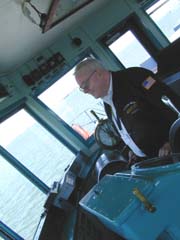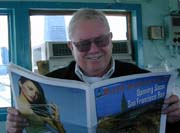Captain Eddie Squire and his crew aboard the John F. Kennedy had a front row seat on the tragic events of September 11, watching as the second plane roared directly overhead into the World Trade Center. Then, they immediately set to work ferrying rescuers in and survivors out.

Published: May, 2002
Staten Island Ferryboat John F. Kennedy and her Crew
The massive double-ender ferry John F. Kennedy carries 6,000 people, but guiding it into its slip at the tip of Manhattan was nothing new for Captain Eddie Squire. He’d been at the helm of a Staten Island ferry for more than twenty years. But today was September 11th, and from his wheelhouse Captain Squire could see smoke pouring from the World Trade Center.
Quite a dramatic sight, and Captain Squire and his passengers had a front-row seat. Nevertheless, the crew and passengers of the John F. Kennedy were prepared to continue about their business. The news reports were that a plane had crashed into the World Trade Center, terrorism was suspected, but accidental causes had not been ruled out. At any rate, the situation seemed under control so the passengers disembarked as usual and Captain Squire made his way to the other end of his ferryboat.
First Mate Frank Dedario joined Captain Squire, and the two men prepared for the routine return trip to Staten Island from their perch high above New York Harbor. The last stragglers were disembarking into Manhattan and Captain Squire was set to give the order to cast off lines when suddenly he and First Mate Dedario heard what they both later described as an “unnatural” noise coming from the water direction. Snapping his head that way, Captain Squire found himself face to face with the second 757, hideously angled, slashing directly toward him at nearly eye height. Pole-axed, he watched – and felt – as it thundered directly over the John F. Kennedy and into the World Trade Center just 9 blocks behind him.
Emergency workers and supplies were already assembling in Staten Island and orders were given to the John F. Kennedy to return at once and bring them to the disaster scene. She was on her way back to Manhattan within forty-five minutes, with hundreds of firefighters and other rescuers aboard frantically changing into their uniforms on the trip over. Abandoning their civilian clothes where they lay, they rushed from the ferryboat the moment it touched Manhattan, many to their deaths when the buildings collapsed soon after.
It was the sad duty of the John F. Kennedy’s crew to collect the personal effects of the fallen heroes. “We put hundreds of shoes into plastic bags,” said Captain Squire, a crazed look in his eye. “Every bit of equipment we had we sent ashore. Then we took back the wounded, the refugees. All we had left to help them was one box of gloves. One box of gloves!”


